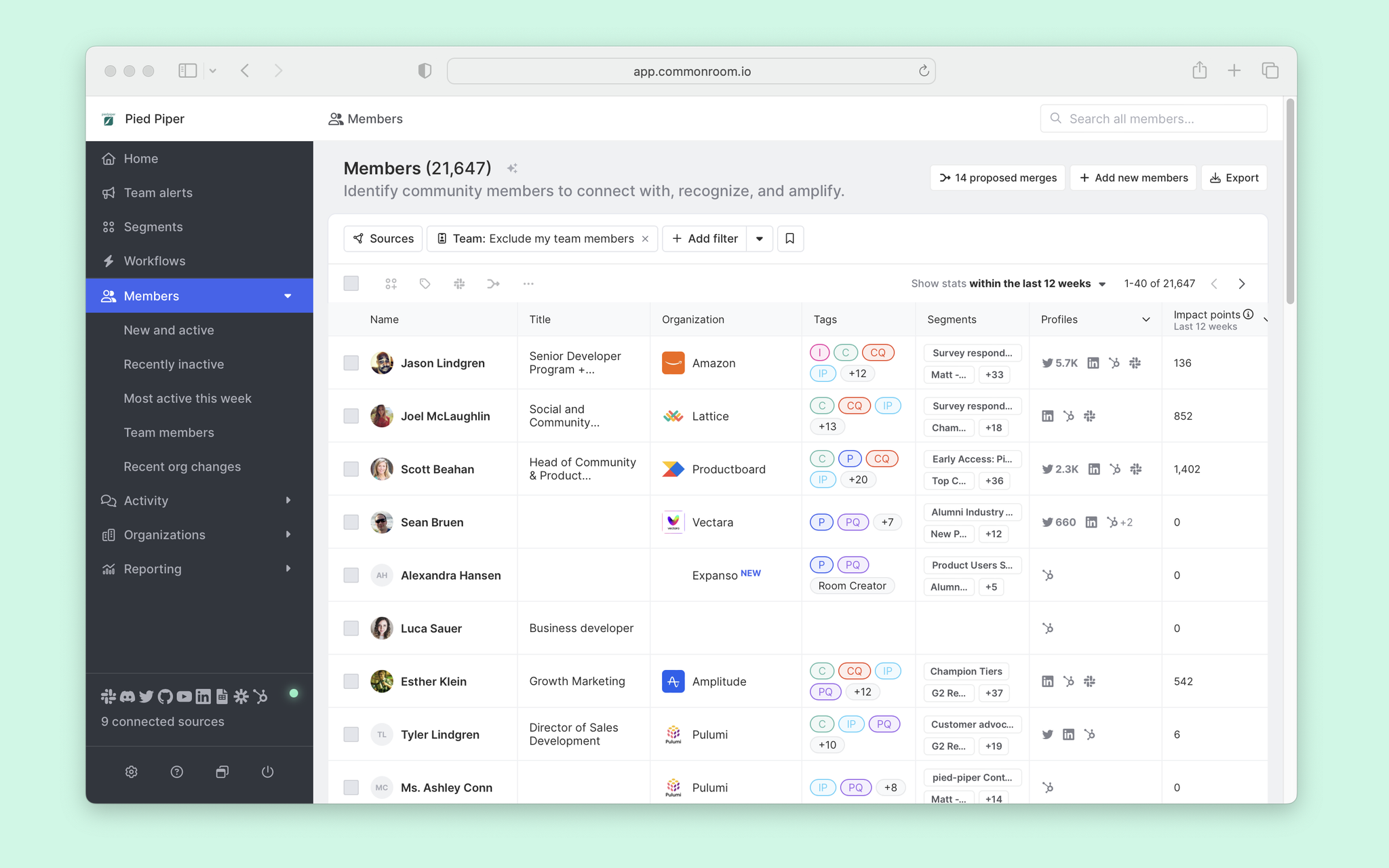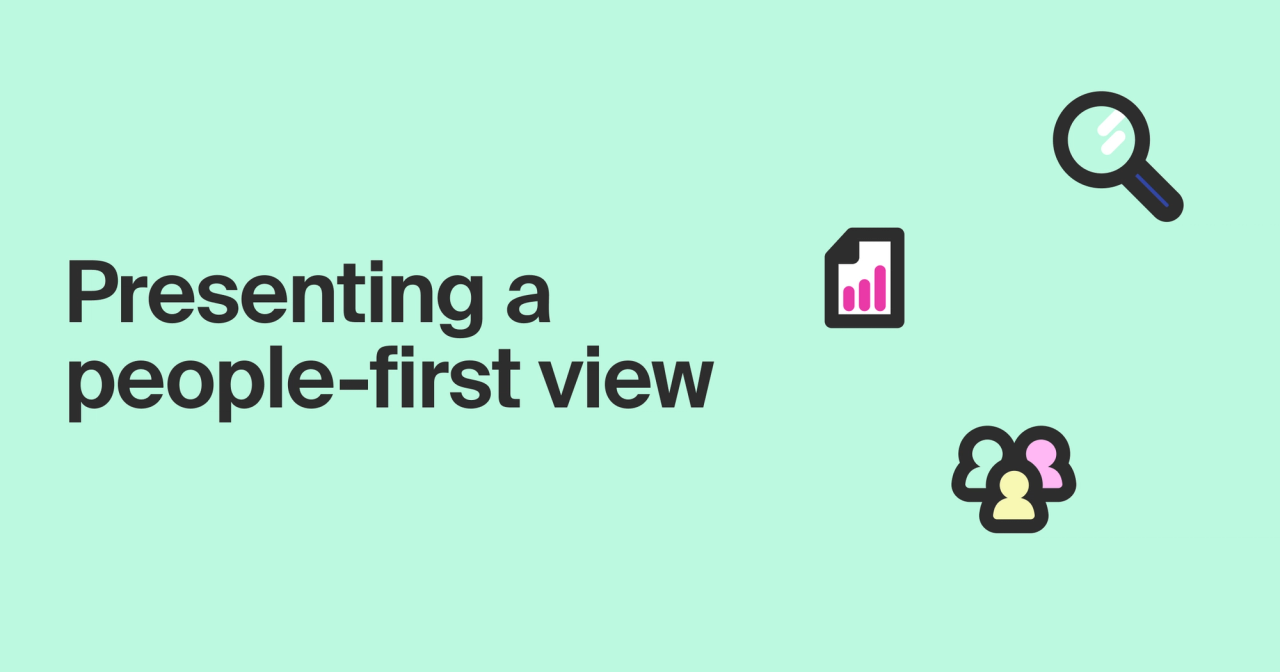Our customers find value in lots of Common Room features, from AI-powered sentiment detection to automated workflows.
But one product feature arguably takes the cake—and it’s one that happens behind the scenes.
I’m talking about how Common Room identifies the individuals and organizations behind digital activity. Namely, how we help you connect the dots between anonymous signals at the top of the funnel and the actual people recorded in your product and CRM.
Our customers are curious about how we do this. Our competitors are, too.
While I can’t tell you all the ingredients that go into our secret sauce, I can share some details on how we resolve and enrich customer profiles (and what we do to make sure they’re as accurate as possible).
Keep reading to learn:
- What goes into creating a people-first view of digital activity
- Why machine learning is crucial to identify resolution and profle enrichment
- How to improve customer profile accuracy
Infinite inputs, one output
After you connect your data sources to Common Room, we automatically create a profile for each and every person who engages with your brand based on their digital activity.
These profiles generally include key demographic information, such as a person's job title, location, and contact information. Just as importantly, they contain relevant actions and behaviors across connected channels.
But individuals aren’t the only ones with profiles in Common Room—the companies they work for have them, too. These profiles serve up critical firmographic details, such as company size, industry, and annual revenue.
You can see which individuals are part of an organization, the sentiment associated with that organization, which channels its employees are most active on, and much more.
Uncovering this information isn’t the hard part. Tedious and time-consuming? Sure, but most of it is publicly available and typically a Google search away.
The hard part is bringing it all together under one roof and using it to create a unified view of your customers.
That’s where the magic behind auto-merge comes in.
Common Room uses machine learning to detect if two or more profiles are the same person and automatically merges them. This gives you a digital relationship management system with a single, enriched view of each person across different data sources.
By combining your digital interaction, product usage, and customer relationship data in Common Room, you get a 360-degree view of each and every customer (and potential customer).
Here’s how we do it.

Customer mystery, solved
Traditional technologies work by taking limited data sources (such as email) and running them through a third-party data provider.
These tools give companies a vague description of individuals and their actions at the account level. There’s low confidence in customer identity and zero context surrounding the customer journey.
Common Room combines traditional and modern data sources—as well as product usage and customer relationship data—to make profiles as full as possible. This includes publicly available first-party data and information from third-party data partners.
The result is a 2-5x improvement over traditional identity resolution tools.
We’ve built tooling to monitor our performance. We’re always striving for 100% accuracy, but that’s not always possible. So we have methods in place that help us continuously track quality and accuracy, which lets us continue to improve.
We measure our success using three metrics:
- Accuracy: how accurate and up to date a profile is
- Coverage: how complete and rich a profile is
- Deduplication: how few duplicate profiles we provide
Since we use various sources of information, the biggest challenge is reconciling conflicting signals. It’s difficult to build an accurate, up-to-date profile when data sources say different things (or have fluctuating levels of data fidelity).
That’s why we run everything through our AI-powered solution. Think of it as digital forensics for the customer journey. The more sources you connect, the higher the match rate and the better the context.
This is hugely valuable for organizations across business functions, from community and developer relations practitioners to marketing and sales professionals. Companies can break down data silos, connect dark-funnel activity to existing data points, and overlay purchase intent with product and customer fit.
When you know exactly who you're talking to and where that person is in the customer journey, you can zero in on the high-intent, high-fit opportunities. More importantly, you can deliver value at the right time, in the right place, and in the right way.
For many of our customers, the ability to see real identities, real intent, and real context—all in real time—is a game-changer.
That said, we also know there are times when you need a human touch.

To merge, or not to merge, that is the question
We like to take the guesswork out of helping our customers get to know theirs.
When a new data source is integrated with Common Room, we'll automatically work to merge any profiles that match existing ones. But if we don't have 100% confidence in a match, we'll propose profiles for you to review and merge on your own.
When we see inconsistencies with profile data, it’s often due to two factors:
- The person’s public information is not up to date (for example, maybe one of their social profiles hasn’t been updated or was very recently updated).
- The data partners we work with have yet to augment their data to reflect the most recent changes across public data sources.
To improve match rates and accuracy, we recommend our customers:
Connect more sources
The more data sources you connect, the better we’re able to match individual and organizational records. We also suggest starting with high-fidelity sources such as LinkedIn, HubSpot, Salesforce, GitHub, and Slack. These sources have a better match rate compared to sources that have a larger anonymous user base.
Review data in Common Room
When you directly edit profiles in Common Room, you not only update the profile with accurate information, you provide us with valuable feedback we can use to improve our product.
We encourage our customers to surface any inaccuracies, coverage issues, or duplicate profiles. With every piece of feedback, we look into the origin of inconsistencies to help us find edge cases and keep improving.
Because we know the better we are at our job, the better you are at yours.
Build stronger customer connections with Common Room
Ready to see how Common Room helps you get full visibility into your customers?
